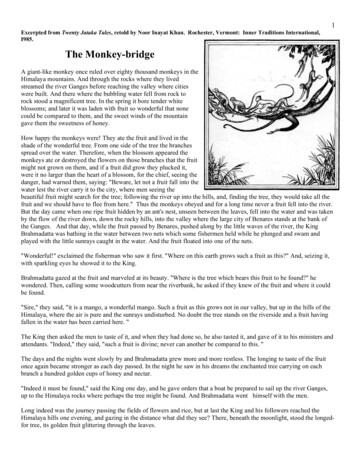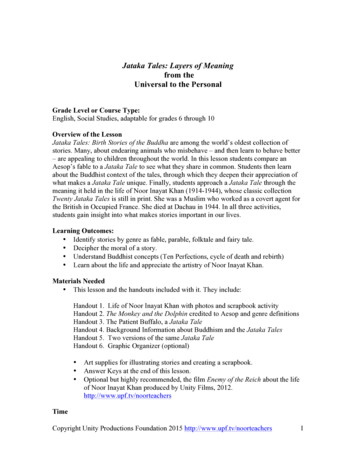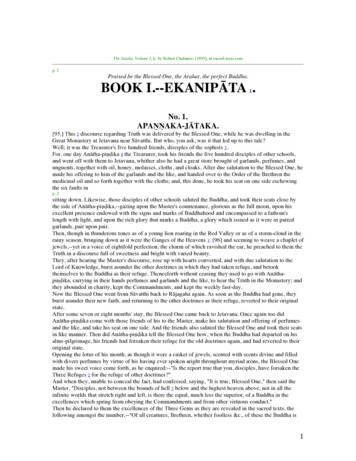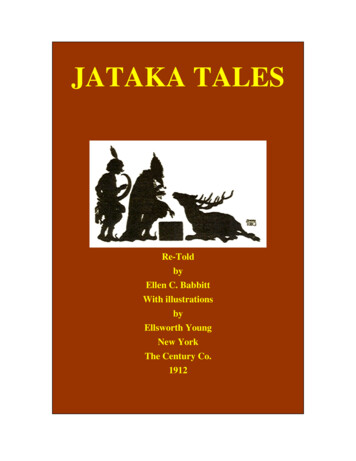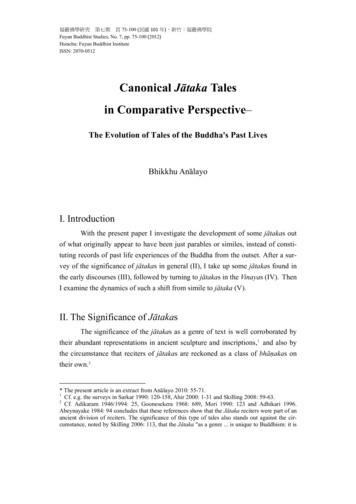
Transcription
MORE JATAKA TALES
MORE JATAKA TALESRE-TOLD BYELLEN C. BABBITTWith illustrations byEllsworth YoungYESTERDAY’S CLASSICSCHAPEL HILL, NORTH CAROLINA
Cover and arrangement 2008 Yesterday’s Classics, LLC.This edition, first published in 2008 by Yesterday’s Classics,an imprint of Yesterday’s Classics, LLC, is an unabridgedrepublication of the text originally published by TheCentury Company in 1922. For the complete listing ofthe books that are published by Yesterday’s Classics,please visit www.yesterdaysclassics.com. Yesterday’sClassics is the publishing arm of the Baldwin OnlineChildren’s Literature Project which presents thecomplete text of hundreds of classic books for childrenat www.mainlesson.com.ISBN-10: 1-59915-310-6ISBN-13: 978-1-59915-310-0Yesterday’s Classics, LLCPO Box 3418Chapel Hill, NC 27515
DEDICATEDtoRUDYARD KIPLINGin the name of all childrenwho troop to his call
FOREWORDThe continued success of the “Jataka Tales,” as retoldand published ten years ago, has led to this second andcompanion volume. Who that has read or told storiesto children has not been lured on by the subtle flatteryof their cry for “more”?Dr. Felix Adler, in his Foreword to “Jataka Tales,”says that long ago he was “captivated by the charm ofthe Jataka Tales.” Little children have not only felt thischarm, but they have discovered that they can readthe stories to themselves. And so “More Jataka Tales”were found in the volume translated from the Sanskritinto English by a group of Cambridge scholars andpublished by the University Press.The Jataka tales, regarded as historic in the ThirdCentury b. c., are the oldest collection of folk-lore extant.They come down to us from that dim far-off time whenour forebears told tales around the same hearthfire onthe roof of the world. Professor Rhys Davids speaksof them as “a priceless record of the childhood of ourrace. The same stories are found in Greek, Latin, Arabic,
Persian, and in most European languages. The Greekversions of the Jataka tales were adapted and ascribedto the famous storyteller, Æsop, and under his namehanded down as a continual feast for the children inthe West,—tales first invented to please and instructour far-off cousins in the East.” Here East, though East,meets West!A “Guild of Jataka Translators,” under ProfessorE. B. Cowell, professor of Sanskrit in the University ofCambridge, brought out the complete edition of theJataka between 1895 and 1907. It is from this sourcethat “Jataka Tales” and “More Jataka Tales” have beenretold.Of these stories, spread over Europe throughliterary channels, Professor Cowell says, “They arethe stray waifs of literature, in the course of their longwanderings coming to be recognized under widelydifferent aspects, as when they are used by Boccaccio,or Chaucer, or La Fontaine.”
CONTENTSThe Girl Monkey and the String ofPearls . . . . . . . . . . . . . . . . . . . . . . . . . . . . . 1The Three Fishes . . . . . . . . . . . . . . . . . . . . . . . . . 6The Tricky Wolf and the Rats. . . . . . . . . . . . 9The Woodpecker, Turtle and Deer . . . . . . 11The Golden Goose . . . . . . . . . . . . . . . . . . . . . . 16The Stupid Monkeys . . . . . . . . . . . . . . . . . . . . . 19The Cunning Wolf . . . . . . . . . . . . . . . . . . . . . . 21The Penny-Wise Monkey. . . . . . . . . . . . . . . . . 23The Red-Bud Tree . . . . . . . . . . . . . . . . . . . . . . . 25The Woodpecker and the Lion . . . . . . . . . . 27The Otters and the Wolf . . . . . . . . . . . . . . . 29How the Monkey Saved his Troop . . . . . . . 31The Hawks and their Friends. . . . . . . . . . . . 36
The Brave Little Bowman . . . . . . . . . . . . . . . 43The Foolhardy Wolf . . . . . . . . . . . . . . . . . . . . 47The Stolen Plow . . . . . . . . . . . . . . . . . . . . . . . . 51The Lion in Bad Company . . . . . . . . . . . . . . . . 54The Wise Goat and the Wolf . . . . . . . . . . . . 57Prince Wicked and the GratefulAnimals . . . . . . . . . . . . . . . . . . . . . . . . . . . 60Beauty and Brownie . . . . . . . . . . . . . . . . . . . . 68The Elephant and the Dog . . . . . . . . . . . . . . 71
THE GIRL MONKEY ANDTHE STRING OF PEARLSONE day the king went for a long walk in thewoods. When he came back to his own garden,he sent for his family to come down to thelake for a swim.When they were all ready to go into the water, thequeen and her ladies left their jewels in charge of theservants, and then went down into the lake.As the queen put her string of pearls away in abox, she was watched by a Girl Monkey who sat in thebranches of a tree near-by. This Girl Monkey wantedto get the queen’s string of pearls, so she sat still andwatched, hoping that the servant in charge of the pearlswould go to sleep.At first the servant kept her eyes on the jewel-box.But by and by she began to nod, and then she fell fastasleep.As soon as the Monkey saw this, quick as the windshe jumped down, opened the box, picked up the stringof pearls, and quick as the wind she was up in the treeagain, holding the pearls very carefully. She put thestring of pearls on, and then, for fear the guards in the1
MORE JATAKA TALESgarden would see the pearls, the Monkey hid them ina hole in the tree. Then she sat near-by looking as ifnothing had happened.By and by the servant awoke. She looked in thebox, and finding that the string of pearls was not there,she cried, “A man has run off with the queen’s stringof pearls.”Up ran the guards from every side.The servant said: “I sat right here beside the boxwhere the queen put her string of pearls. I did not movefrom the place. But the day is hot, and I was tired. Imust have fallen asleep. The pearls were gone when Iawoke.”The guards told the king that the pearls weregone.“Find the man who stole the pearls,” said the king.Away went the guards looking high and low for thethief.After the king had gone, the chief guard said tohimself:“There is something strange here. These pearls,”thought he, “were lost in the garden. There was a strongguard at the gates, so that no one from the outsidecould get into the garden. On the other hand, there arehundreds of Monkeys here in the garden. Perhaps oneof the Girl Monkeys took the string of pearls.”Then the chief guard thought of a trick that wouldtell whether a Girl Monkey had taken the pearls. So2
MORE JATAKA TALEShe bought a number of strings of bright-colored glassbeads.After dark that night the guards hung the stringsof glass beads here and there on the low bushes in thegarden. When the Monkeys saw the strings of brightcolored beads the next morning, each Monkey ran fora string.But the Girl Monkey who had taken the queen’sstring of pearls did not come down. She sat near thehole where she had hidden the pearls.The other Monkeys were greatly pleased with theirstrings of beads. They chattered to one another aboutthem. “It is too bad you did not get one,” they said toher as she sat quietly, saying nothing. At last she couldstand it no longer. She put on the queen’s string of pearlsand came down, saying proudly: “You have only stringsof glass beads. See my string of pearls!”Then the chief of the guards, who had been hidingnear-by, caught the Girl Monkey. He took her at onceto the king.“It was this Girl Monkey, your Majesty, who tookthe pearls.”The king was glad enough to get the pearls, but heasked the chief guard how he had found out who tookthem.The chief guard told the king that he knew no onecould have come into the garden and so he thoughtthey must have been taken by one of the Monkeys in4
THE GIRL MONKEY AND THE STRING OF PEARLSthe garden. Then he told the king about the trick hehad played with the beads.“You are the right man in the right place,” said theking, and he thanked the chief of the guards over andover again.5
THE THREE FISHESONCE upon a time three Fishes lived in a faraway river. They were named Thoughtful,Very-Thoughtful, and Thoughtless.One day they left the wild country where no menlived, and came down the river to live near a town.Very-Thoughtful said to the other two: “There isdanger all about us here. Fishermen come to the riverhere to catch fish with all sorts of nets and lines. Letus go back again to the wild country where we usedto live.”But the other two Fishes were so lazy and so greedythat they kept putting off their going from day to day.But one day Thoughtful and Thoughtless wentswimming on ahead of Very-Thoughtful and they didnot see the fisherman’s net and rushed into it. VeryThoughtful saw them rush into the net.“I must save them,” said Very-Thoughtful.So swimming around the net, he splashed in thewater in front of it, like a Fish that had broken throughthe net and gone up the river. Then he swam back of6
THE THREE FISHESthe net and splashed about there like a Fish that hadbroken through and gone down the river.The fisherman saw the splashing water and thoughtthe Fishes had broken through the net and that one hadgone up the river, the other down, so he pulled in thenet by one corner. That let the two Fishes out of the netand away they went to find Very-Thoughtful.“You saved our lives, Very-Thoughtful,” theysaid, “and now we are willing to go back to the wildcountry.”So back they all went to their old home where theylived safely ever after.7
THE TRICKY WOLFAND THE RATSONCE upon a time a Big Rat lived in the forest,and many hundreds of other Rats called himtheir Chief.A Tricky Wolf saw this troop of Rats, and began toplan how he could catch them. He wanted to eat them,but how was he to get them? At last he thought of aplan. He went to a corner near the home of the Ratsand waited until he saw one of them coming. Then hestood up on his hind legs.The Chief of the Rats said to the Wolf, “Wolf, whydo you stand on your hind legs?”“Because I am lame,” said the Tricky Wolf. “It hurtsme to stand on my front legs.”“And why do you keep your mouth open?” askedthe Rat.“I keep my mouth open so that I may drink in allthe air I can,” said the Wolf. “I live on air; it is my onlyfood day after day. I can not run or walk, so I stay here.I try not to complain.” When the Rats went away theWolf lay down.9
MORE JATAKA TALESThe Chief of the Rats was sorry for the Wolf, andhe went each night and morning with all the other Ratsto talk with the Wolf, who seemed so poor, and whodid not complain.Each time as the Rats were leaving, the Wolf caughtand ate the last one. Then he wiped his lips, and lookedas if nothing had happened.Each night there were fewer Rats at bedtime. Thenthey asked the Chief of the Rats what the trouble was.He could not be sure, but he thought the Wolf was toblame.So the next day the Chief said to the other Rats,“You go first this time and I will go last.”They did so, and as the Chief of the Rats went by,the Wolf made a spring at him. But the Wolf was notquick enough, and the Chief of the Rats got away.“So this is the food you eat. Your legs are not so lameas they were. You have played your last trick, Wolf,” saidthe Chief of the Rats, springing at the Wolf ’s throat. Hebit the Wolf, so that he died.And ever after the Rats lived happily in peace andquiet.10
THE WOODPECKER,TURTLE AND DEERONCE upon a time a Deer lived in a forestnear a lake. Not far from the same lake, aWoodpecker had a nest in the top of a tree;and in the lake lived a Turtle. The three were friends,and lived together happily.A hunter, wandering about in the wood, saw thefoot-prints of the Deer near the edge of the lake. “I musttrap the Deer, going down into the water,” he said, andsetting a strong trap of leather, he went his way.Early that night when the Deer went down todrink, he was caught in the trap, and he cried the cryof capture.At once the Woodpecker flew down from her treetop, and the Turtle came out of the water to see whatcould be done.Said the Woodpecker to the Turtle: “Friend, youhave teeth; you gnaw through the leather trap. I willgo and see to it that the hunter keeps away. If we bothdo our best our friend will not lose his life.”11
MORE JATAKA TALESSo the Turtle began to gnaw the leather, and theWoodpecker flew to the hunter’s house.At dawn the hunter came, knife in hand, to the frontdoor of his house.The Woodpecker, flapping her wings, flew at thehunter and struck him in the face.The hunter turned back into the house and lay downfor a little while. Then he rose up again, and took hisknife. He said to himself: “When I went out by the frontdoor, a Bird flew in my face; now I will go out by theback door.” So he did.The Woodpecker thought: “The hunter went outby the front door before, so now he will leave by theback door.” So the Woodpecker sat in a tree near theback door.12
THE WOODPECKER, TURTLE AND DEERWhen the hunter came out the bird flew at himagain, flapping her wings in the hunter’s face.Then the hunter turned back and lay down again.When the sun arose, he took his knife, and started outonce more.This time the Woodpecker flew back as fast asshe could fly to her friends, crying, “Here comes thehunter!”By this time the Turtle had gnawed through allthe pieces of the trap but one. The leather was so hardthat it made his teeth feel as if they would fall out. Hismouth was all covered with blood. The Deer heard theWoodpecker, and saw the hunter, knife in hand, comingon. With a strong pull the Deer broke this last piece ofthe trap, and ran into the woods.The Woodpecker flew up to her nest in the treetop.But the Turtle was so weak he could not get away.He lay where he was. The hunter picked him up andthrew him into a bag, tying it to a tree.The Deer saw that the Turtle was taken, and madeup his mind to save his friend’s life. So the Deer let thehunter see him.The hunter seized his knife and started after theDeer. The Deer, keeping just out of his reach, led thehunter into the forest.When the Deer saw that they had gone far intothe forest he slipped away from the hunter, and swift13
THE WOODPECKER, TURTLE AND DEERas the wind, he went by another way to where he hadleft the Turtle.But
Th e Jataka tales, regarded as historic in the Th ird Century b. c., are the oldest collection of folk-lore extant. Th ey come down to us from that dim far-off time when our forebears told tales around the same hearthfi re on the roof of the world. Professor Rhys Davids speaks of them as “a priceless record of the childhood of our race. Th e same stories are found in Greek, Latin, Arabic .

